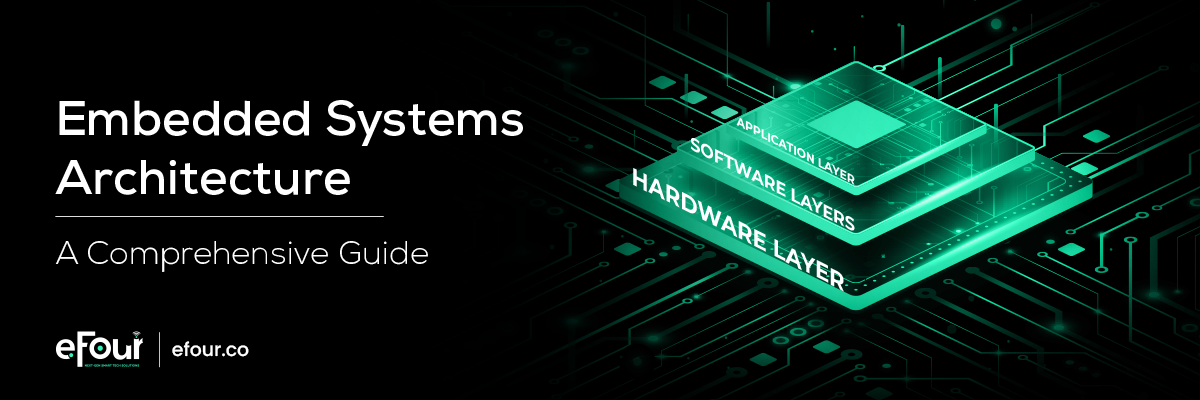
Embedded systems architecture are computer systems that have been designed to control or monitor the operation of a particular device or system. They are often found in the form of embedded controllers, which are a part of the electronics that we use on a daily basis. Embedded systems are everywhere – they’re in our cars, in our appliances, and even in our smartphones.
They help us do everything from controlling traffic lights to managing power grids. This is why embedded systems architecture is so important – without it, we wouldn’t have any technology at all. With that stated, let’s dive into this blog to understand the significance of embedded systems architecture and have an overall view.
Embedded systems architecture is a system design that includes a microcontroller and embedded software. The design process comprises selecting hardware components, designing the embedded software, and assembling the hardware to create an embedded system.
An embedded system is a computer system that performs one or more dedicated functions without having to be directly programmed. Embedded systems are often developed to perform tasks that are too difficult or time-consuming for general-purpose computers.
Embedded systems are an integral part of the modern world. They are used in a variety of applications, from cars to smartphones.
Embedded systems architecture design has three layers:
Hardware includes all physical components that an embedded system is made up of, including microprocessors, memory, and other peripherals. Software is the programming that runs on the hardware and the application layer is the programming that controls how these components interact with one another. The three layers work together to provide a cohesive system for embedded devices to function properly without any human interaction needed.
An embedded system design is a system that has been designed to meet the needs of a specific application. The design is usually built into the hardware and software of a product.
Embedded systems are used in many different industries, from cars to home appliances. They have also become increasingly popular in IoT devices, such as smart thermostats and doorbells.
These are computer systems that have been designed to control or monitor the operation of a particular device or system. They are often found in the form of embedded controllers, which are a part of the electronics that we use on a daily basis.
Embedded software architecture is a type of software architecture that is used to control embedded systems. Embedded systems are computers built into a device. They can be found in many different types of equipment, such as cars, televisions, appliances, and even toys.
The main difference between an embedded system and a general computer is that the embedded system does not have a keyboard, monitor, or mouse. The only way to interact with the system is through some programming language like C++ or Java.
Embedded software architects need to know how to write code for these devices so they can communicate with them. This means they need to know about all the device’s hardware functions, including its sensors and actuators. It also means knowing what programming languages are available for each device.
Read more: Hardware Vs Software
Embedded systems are often used to control the product or machine they are embedded in. They can be used for various purposes, such as controlling the speed of an engine and monitoring the pressure inside a tire.
Some of the essential traits of an embedded system include the following:
Designing Embedded Systems is a complex process. There are many things to keep in mind when designing and developing the Architecture of an Embedded System. These include the following:
The embedded software is tested in a variety of ways. The testing process is often iterative, with the code being tested, analyzed for errors, and rewritten several times. The first step of testing is ensuring the code will compile. This means that all the necessary files are present and that they can be compiled into an executable program or library.
Testing of embedded software mainly includes two types:
Unit tests test a small part of one module or function at a time. System tests are performed by running many modules together to see how they interact with each other.
Embedded systems architecture is important because it is the backbone of our technological world. These are the core of all machines, devices, and gadgets that we use on a daily basis. Embedded software architecture is a computer programming approach in which the software is written directly into the hardware simultaneously.
This architecture provides many advantages, some of which are:
Embedded software development is a complex and challenging task. There are many things to consider when selecting a company to work with.
The rapid development of embedded systems architecture, which is the core of embedded system design, can be attributed to the following factors:
The emergence of embedded systems architecture has been a major technological shift that has changed how we do things. It has changed how we design, manufacture, and use products. Embedded systems design is growing in popularity as the world becomes more and more connected. This growth can be seen in the rise of IoT devices. The future of this field is promising. With the rise of IoT devices, there will be a need for embedded systems designers to create and maintain these devices.
This blog is to understand the significance of embedded systems architecture and have an overall…
This blog is to understand the significance of embedded systems architecture and have an overall…
This blog is to understand the significance of embedded systems architecture and have an overall…
This blog is to understand the significance of embedded systems architecture and have an overall…
This blog is to understand the significance of embedded systems architecture and have an overall…
This blog is to understand the significance of embedded systems architecture and have an overall…